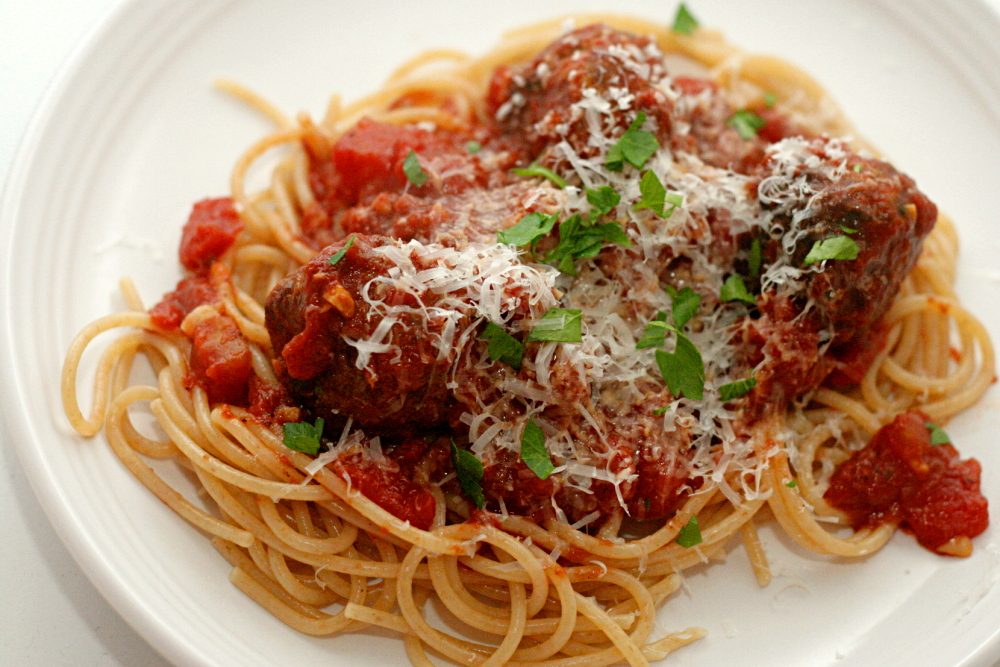Dave recently told me that he’d prefer to eat less meat. Because I do all of the meal planning and cooking, we generally have an understanding that I get control over what we eat. On the other hand, Dave is so open-minded about what we eat that it’s fair for him to offer up some opinions.
And our meat intake has increased in the last few months. We used to eat meat around 1-3 times per week, and lately we’ve been eating vegetarian around 1-3 times per week. Because I have more free time lately, I’ve been more adventurous with my cooking, and because I don’t have as much experience cooking with meat, it’s more challenging for me. (In other words, I’m not very good at it.)
But Dave’s right, we should eat less meat. For our health, for our budget, for the environment.
This recipe for whole wheat pasta with greens, beans, tomatoes, and garlic chips is definitely Dave’s type of meal.
This is only a quarter of the kale the recipe calls for, or just under one serving. (I cut the recipe in half, and accidentally only bought half as much kale as I needed.) Hey, he asked for more vegetables…
The pasta, wholesome though it is, is surprisingly flavorful. A dish like this lends itself well to personalization. I left out the olives, because they’re one of Dave’s few food hang-ups. Because I only made half the recipe for the two of us, I’m left with half a can of beans and half a can of tomatoes leftover. I plan on doubling those ingredients in the future so I can use the whole can. I only used half the amount of kale the recipe calls for, which was convenient because it was one bunch. I could see how more would be good, although I don’t know if I’d want twice as much.
The recipe did take longer to prepare than I prefer for a weeknight pasta dish. Using bags of pre-washed spinach would cut down on prep time and cooking time. The garlic chips are a nice addition, but could also be skipped to save time.
All in all, this was a great tasting dish with lots of vegetables and no meat, as per Dave’s request.
Whole Wheat Pasta with Greens, Beans, Tomatoes, and Garlic Chips (from Cooks Illustrated November 2005)
Serves 4 to 6
CI note: If you can’t find a 13.25-ounce package of Ronzoni, the winner of our tasting, use ¾ pound of a whole wheat pasta of your choice. If you like, pass extra-virgin olive oil for drizzling over the finished pasta. For a vegetarian dish, substitute vegetable broth for chicken broth.
Variation: Spinach can be substituted for the greens. Replace kale or collards with two 10-ounce bags of crinkly-leaf spinach, trimmed, chopped into 1-inch pieces, and rinsed, water still clinging to leaves (about 16 cups), and reducing chicken broth to ¾ cup. After adding second half of spinach to pan, cook for 2 minutes, until spinach is completely wilted. Continue with recipe as directed.
3 tablespoons olive oil
8 cloves garlic, 5 cloves sliced thin lengthwise, 3 cloves minced or pressed through garlic press (1 tablespoon)
Table salt
1 medium onion, diced small (about 1 cup)
½ teaspoon hot red pepper flakes
14 cups kale (loosely packed) or collard greens (1 to 1½ pounds), thick stems trimmed, leaves chopped into 1-inch pieces and rinsed, water still clinging to leaves
1½ cups low-sodium chicken broth
1 can (14½ ounces) diced tomatoes, drained
1 can (15 ounces) cannellini beans, drained and rinsed
¾ cup pitted kalamata olives, roughly chopped
13¼ ounces whole wheat spaghetti
2 ounces Parmesan cheese, finely grated (about 1 cup), plus additional for serving
Ground black pepper
1. Heat oil and sliced garlic in 12-inch straight-sided sauté pan over medium-high heat. Cook, stirring and turning frequently, until light golden brown, about 3 minutes. Using slotted spoon, transfer garlic to plate lined with paper towels. Sprinkle lightly with salt.
2. Add onion to pan; cook until starting to brown, about 5 minutes. Add minced garlic and red pepper flakes; cook, stirring constantly, until garlic is fragrant, about 30 seconds.
3. Add half of greens to pan; using tongs, toss occasionally, until starting to wilt, about 2 minutes. Add remaining greens, broth, and ¾ teaspoon salt; cover (pan will be very full); increase heat to high and bring to strong simmer. Reduce heat to medium and cook, covered, tossing occasionally, until greens are tender, about 15 minutes (mixture will be somewhat soupy). Stir in beans and olives.
4. Meanwhile, bring 4 quarts water to boil in Dutch oven over high heat. Add spaghetti and 1 tablespoon salt; cook until pasta is just shy of al dente. Drain pasta and return to pot. Add greens mixture to pasta, set over medium-high heat, and toss to combine. Cook until pasta absorbs most of liquid, about 2 minutes. Stir in 1 cup Parmesan; adjust seasoning with salt and pepper. Serve immediately, passing garlic chips, extra-virgin olive oil, and Parmesan separately.





























